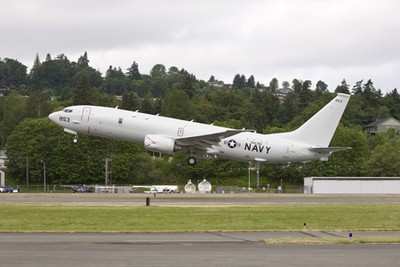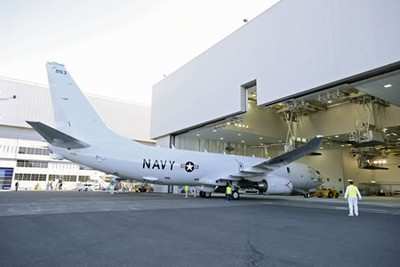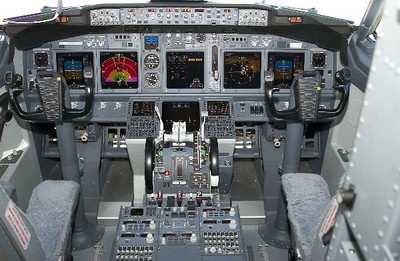Sat, Jun 06, 2009
Successful Test Flight Gets Second Flight Test Article Into
Program
A Boeing P-8A Poseidon test aircraft (T2) took off from Renton
Field, Friday, to begin its first flight. T2 took off at 10:32 a.m.
Pacific time and landed two hours and 56 minutes later at Boeing
Field in Seattle at 1:28 p.m.

The flight plan for T2, painted in its new U.S. Navy livery,
included a flyby of Naval Air Station Whidbey Island, Wash., to
give Navy personnel a close-up look at the Poseidon. The Navy is
purchasing 117 P-8As to replace its fleet of P-3Cs.
The anti-submarine warfare aircraft reached a maximum altitude
of 25,000 feet as pilots performed airborne systems checks such as
engine accelerations and decelerations, autopilot flight modes and
auxiliary power unit shutdowns and starts.

Boeing's team is developing the P-8A Poseidon for the U.S. Navy.
The Navy plans to purchase 108 P-8As with the first test aircraft
to be delivered in 2009. Initial operational capability is
scheduled for 2013. In January 2009 Boeing was selected to provide
eight P-8I long-range maritime reconnaissance and anti-submarine
warfare aircraft to the Indian navy. India is the first
international customer for the P-8. Boeing believes there are
numerous other opportunities for international sales to countries
currently operating P-3s or similar maritime patrol aircraft.
International interest has been expressed by a number of
countries.
The team started production on the first of five test aircraft
December 11, 2007 at industry partner Spirit AeroSystems’
Wichita, Kan., facility. Fuselage assemblies come together on
Spirit’s existing Next-Generation 737 production line. Spirit
delivered the first fuselage to Boeing in late March 2008 and final
assembly of the aircraft began the same day in Renton, Wash.
On-schedule assembly milestones that followed included wing-to-body
join and the start of a moving line in May, completion of
“power on” and engine installation in June and
completion of final assembly in July.

T2 is the third of five test aircraft being assembled and tested
as part of the System Development and Demonstration contract that
Boeing received in 2004. T1, the program’s first test
aircraft, completed its first flight on April 25.
More News
Charted Visual Flight Procedure Approach An approach conducted while operating on an instrument flight rules (IFR) flight plan which authorizes the pilot of an aircraft to proceed >[...]
“When l became the Secretary of Defense, I committed to rebuild our military to match threats to capabilities. Drones are the biggest battlefield innovation in a generation, >[...]
Aero Linx: Stearman Restorers Association Welcome to the Stearman Restorers Association. The Stearman Restorers Association is an independent “Not for Profit” 501C-3 Co>[...]
Airplane Exhibited A Partial Loss Of Engine Power When It Was About Halfway Down The Runway Analysis: The pilot of the experimental amateur-built airplane was departing from his pr>[...]
The Flight Path Was Consistent With Low-Altitude Maneuvering On June 18, 2025, about 0922 mountain standard time, a Cessna A150L airplane, N6436F, was substantially damaged when it>[...]
 ANN's Daily Aero-Term (07.15.25): Charted Visual Flight Procedure Approach
ANN's Daily Aero-Term (07.15.25): Charted Visual Flight Procedure Approach Aero-News: Quote of the Day (07.15.25)
Aero-News: Quote of the Day (07.15.25) ANN's Daily Aero-Linx (07.15.25)
ANN's Daily Aero-Linx (07.15.25) NTSB Final Report: Kjelsrud Gary Kitfox
NTSB Final Report: Kjelsrud Gary Kitfox NTSB Prelim: Cessna A150L
NTSB Prelim: Cessna A150L





